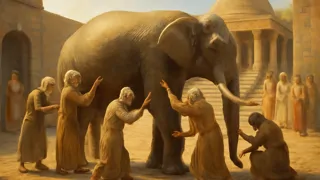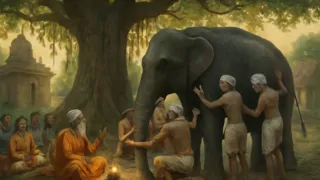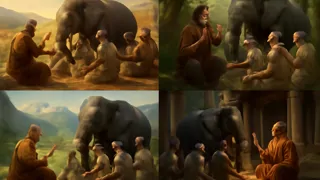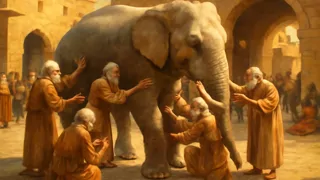Introduction
In the heart of an ancient Indian village, where textured sandstone walls glowed amber in the dawn’s soft light, a curious gathering took shape around an enormous, gentle creature. Merchants paused in their morning routines, and villagers leaned against wooden columns, all drawn by a promise of wisdom. The day’s dry air carried the distant pangs of temple bells and the chatter of traders, but above it all rose a sense of expectancy: six blind men had come to feel an elephant for the very first time, each eager to describe what lay before them. Their cane tips tapped cautiously on the courtyard floor, their fingers trembling with excitement as they prepared to confront the unknown through the simple but profound act of touch. In that quiet moment before contact, the elephant’s presence was almost mythic, a living tapestry of memory, tradition, and hidden truth.
As the first man reached out to the elephant’s broad flank, he found only a sturdy, rough expanse and proclaimed the creature to be like the wall of a great fortress. The next felt the tusk—smooth, curved, and blade-like—and declared it to be as sharp as a lance. One probed the elephant’s trunk, imagining a great snake writhing at his fingertips, while another encountered a pillar-thick leg and likened it to the trunk of a mighty tree. Each man was adamant in his conviction, convinced that his portion of the elephant revealed its total form. Their voices rose in heated debate, each perspective claiming absolute truth.
Yet the village elder, seated on a low stone bench beneath a mango tree dripping with dew-kissed leaves, watched with a patient smile. He saw in their argument a mirror of life itself: how individual viewpoints, though sincere and heartfelt, often miss the larger reality. He waited for the moment when curiosity would yield to understanding, when they might set aside rigid belief and embrace a shared vision. That moment came only after the six blind men stepped back, their hearts unsettled and their convictions shaken, realizing that none of their encounters alone could define the magnificent whole before them. Together, guided by the elder’s gentle counsel, they would weave their impressions into a tapestry of insight, discovering that the elephant’s true shape arises when we honor every viewpoint.
First Encounter: Touching the Elephant’s Side
The courtyard lay bathed in the gentle glow of morning light, coins chinking from passing merchants and pigeons cooing softly overhead. The first blind man, named Arun, approached with reverent caution. His fingers outstretched, he pressed them against the elephant’s broad, dusty flank. The skin was rough and ridged like weathered rock, its surface marked by scars that told of battles fought and seasons endured. Each ridge ran parallel in gentle curves that hinted at the vastness hidden beneath. Arun ran his hand back and forth, absorbing the steady warmth that radiated from the creature’s great mass. In his mind, he pictured an unyielding wall, unshakeable and resolute, and proclaimed, “This elephant is but a great fortress, a towering barrier against the world.” His voice echoed across the courtyard, confident and clear.

Surakta, the second man, stepped forward to feel the elephant’s ivory tusk. His fingertips traced along its smooth, polished surface, marveling at its curvature and strength. He imagined a mighty spear carved from the purest bone, capable of splitting the earth itself. When he withdrew his hand, he exclaimed, “This animal is nothing less than a fearsome lance, sharp and unerring.” The villagers murmured as their fathers and mothers shared knowing glances, for they recognized the familiar dance of certain conviction.
Not far from them stood Kavi, the third of the six, who prefaced his exploration with a prayer to Ganesha, the remover of obstacles. He then placed both hands upon the elephant’s swinging trunk, marveling at its supple sinews. Each coil, each subtle twitch revealed to him the sinuous form of the holy naga serpent. “An elephant? No,” he insisted. “It is a living serpent, twisting and turning.” His tone was humbled. The notion of a serpent evoked reverence, prompting many gathered to bow their heads in unease.
Meanwhile, Dinanath reached the animal’s leg—a mighty column of flesh and muscle that spanned wide as a temple pillar. He wrapped his arms fully, marveling at its girth and the playful ripple of muscle under his palms. In his mind’s eye, he saw the great redwood trees of the forests, towering into the heavens. “It must be a tree,” he declared, “the tallest trunk you can imagine.” His deep, booming voice carried conviction that left onlookers nodding in respect.
The remaining two men, Balram and Chand, circulated the elephant’s body in search of more clues. Balram, sensing the soft underbelly, concluded it was a vast cushion of cloth. Chand, touching the tail, believed he’d found a long rope. The debate that followed split the courtyard. Each man’s certainty clashed against the others’, and heated words tumbled into frustration.
After long minutes of impassioned argument, the village elder stepped forward, calling them to stand together. “Each of you has felt only one part,” he said gently. “But the elephant is more than any single piece. Only through respect for each perspective can you perceive the whole.” He guided them to share and listen, weaving their pieces into a single image: a creature vast and complex, not a wall nor a spear nor a serpent nor a tree nor cloth nor rope, but all of these in harmony.
Debate and Discovery: Piecing Together Truth
Once the men gathered beneath the shade of a broad banyan tree, their voices still reverberating with conviction, the elder invited them to recount their experiences more patiently. Arun described the flank as a massive, unyielding wall, each scar a story etched into time. Surakta spoke again of the tusk’s lethal elegance. Kavi bowed his head, maintaining his serpent vision, while Dinanath’s tone rumbled like distant thunder as he shared imagery of a forest’s greatest tree trunk. Balram and Chand added their unique insights about softness and rope-like contours. As each retold their encounter, the elder gently wove the disparate threads.

“There is much truth in all of your words,” he said. “An elephant’s side can be broad and rough as a fortress. Its tusk gleams like a spear, and its trunk coils like a serpent. Its legs stand firm like tree trunks, its belly feels soft like cloth, and its tail can resemble a heavy rope. None of you lied, but none of you saw the entire creature.” The blind men looked at one another and realized how easily singular focus can blind one to larger reality. Their earlier certainty now gave way to wonder. They listened as the elder described how each part fits into the graceful whole—a creature of empathy and intelligence, whose presence commands respect.
Moved by newfound humility, they formed a circle around the elephant, placing their hands together upon its hide. In that act of unity, they embraced not just a single truth, but multiple truths, each essential. Their voices softened as they murmured gratitude to the animal and to one another.
News of their revelation spread throughout the village, reaching distant farms and marketplaces. Travelers passing through learned of the blind men’s lesson and carried it onward, sharing the parable across kingdoms and eras.
Even now, whenever people argue heatedly over a single viewpoint, the story returns like a gentle breeze, reminding us that true understanding comes when we listen, share, and honor perspectives beyond our own. After all, only by piecing together every part can the majestic tapestry of reality reveal itself in full.
Unity of Vision: The Parable’s Enduring Legacy
Over generations, this gentle parable of the elephant and the blind men traveled far beyond its Indian origins. It found its way into the halls of scholars, the teachings of sages, and the conversations of common folk. In every retelling, listeners are reminded that no single viewpoint holds the entire truth. The story encourages humility before complexity and teaches that wisdom emerges from shared insight.

In distant lands, merchants adapted the tale to their own cultures. In one desert town, a local storyteller replaced the elephant with a camel, yet the lesson remained unwavering. In a snowbound hamlet, the beast became a snow fox, still prompting villagers to grasp at parts and piece together the elusive whole. Despite these variations, the core message endures: reality is multifaceted, and harmony arises from embracing each facet.
Intellectuals cite the parable in philosophical debates, emphasizing that science, art, and ethics flourish when multiple perspectives converge. Educators use it to teach children empathy, listening skills, and collaborative problem-solving. Even in modern boardrooms, teams invoke the blind men and the elephant when aligning diverse viewpoints toward a shared goal.
The strength of the parable lies in its simplicity and its capacity to transcend time, place, and discipline. It invites each of us to pause before declaring absolute certainty, to extend our hands toward understanding, and to weave our piece of the puzzle into a collective tapestry. In doing so, we honor the full complexity of life and nurture the seeds of empathy and unity in every heart that listens.
Conclusion
As the sun dipped low and cast long shadows across the ancient stones, the six blind men stood together with hands still resting gently upon the elephant’s great body. No longer separate voices in heated debate, they formed a unified chorus of insight. Each man had touched a part, yet now they grasped the whole through mutual respect and shared wisdom. They bowed to the creature that had taught them a lesson far more profound than any could have imagined alone: that the tapestry of truth emerges only when we honor every strand. Centuries later, this parable continues to whisper its message across deserts and cities, reminding us that understanding flourishes in the space between perspectives. In a world divided by certainties, may we, like the blind men, learn to listen, combine our insights, and embrace the vast, intricate reality that lies just beyond the touch of one hand.


















